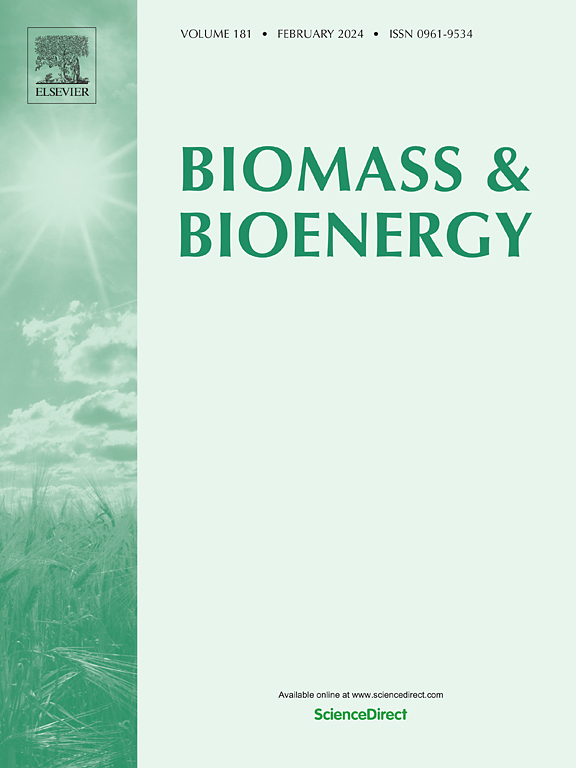从杉木种子优化生物柴油生产及其排放分析:可再生能源的可持续非食用原料
IF 5.8
2区 生物学
Q1 AGRICULTURAL ENGINEERING
引用次数: 0
摘要
生物柴油生产对食用原料的依赖引发了人们对粮食短缺的担忧,促使人们寻找可持续的替代品。本研究调查了杉木(Maesa lanceolata),这是一种非食用且很少被开发的原料,在东非、中非、南非、马达加斯加和南亚盛产,作为生物柴油的来源。采用溶剂法提取油,得率为32.2%。以甲醇和碱催化剂为原料,通过酯交换反应合成生物柴油,并采用响应面法(RSM)和中心复合设计(CCD)对工艺进行优化。二次模型预测生物柴油产率,调整后R2为0.9766,证实了模型的准确性。最佳酯交换参数为甲醇油摩尔比为6:1,反应时间为60 min,反应温度为60℃,催化剂浓度为1.5 wt%,实验所得甲酯收率为92.33%。气相色谱-质谱(GC-MS)鉴定了脂肪酸酯,生物柴油符合EN 14214和ASTM 6751标准。使用单缸、四冲程、7.5 kW压缩点火发动机,在变速和恒负载下进行CO、CO2、HC和NOx的排放测试。结果表明,与B0相比,B20的CO2排放量从1.3%下降到0.8%,HC排放量从10.5%下降到7.1%,CO排放量从22.8%下降到24.1%。然而,B10的增幅最小,在相同的转速范围内,NOx从10.0%上升到5.1%。这项研究强调了杉木生物柴油替代柴油的潜力,同时使原料多样化,并有助于可持续的生物柴油生产。本文章由计算机程序翻译,如有差异,请以英文原文为准。
Optimized biodiesel production from Maesa lanceolata seeds and its emission analysis: A sustainable non-edible feedstock for renewable energy
The reliance on edible feedstocks for biodiesel production raises concerns about food shortages, driving the search for sustainable alternatives. This study investigates Maesa lanceolata, a non-edible and scarcely exploited feedstock abundant in East, Central, and South Africa, Madagascar, and southern Asia, as a biodiesel source. Oil was extracted using solvent techniques, achieving a yield of 32.2 %. Biodiesel was synthesized via transesterification with methanol and an alkali catalyst, and process optimization was conducted using the response surface method (RSM) with central composite design (CCD). A quadratic model predicted biodiesel yield with an adjusted R2 of 0.9766, confirming model accuracy. Optimal transesterification parameters were the methanol-to-oil molar ratio of 6:1, the reaction time of 60 min, the temperature of 60 °C, and the catalyst concentration of 1.5 wt%, yielding 92.33 % methyl esters experimentally. Gas chromatography-mass spectrometry (GC-MS) identified fatty acid esters, and the biodiesel met EN 14214 and ASTM 6751 standards. Emissions tests for CO, CO2, HC, and NOx were conducted at variable speeds and constant load using a single-cylinder, 4-stroke, 7.5 kW compression ignition engine. The results showed that B20 performed best, with CO2 emissions decreasing from 1.3 % to 0.8 %, HC emissions dropping from 10.5 % to 7.1 %, and CO emissions reducing between 22.8 % and 24.1 % compared to B0. However, B10 showed the smallest increase, with NOx rising from 10.0 % to 5.1 % within the same speed range. This study highlights the potential of Maesa lanceolata biodiesel to substitute diesel fuel while diversifying feedstocks and contributing to sustainable biodiesel production.
求助全文
通过发布文献求助,成功后即可免费获取论文全文。
去求助
来源期刊

Biomass & Bioenergy
工程技术-能源与燃料
CiteScore
11.50
自引率
3.30%
发文量
258
审稿时长
60 days
期刊介绍:
Biomass & Bioenergy is an international journal publishing original research papers and short communications, review articles and case studies on biological resources, chemical and biological processes, and biomass products for new renewable sources of energy and materials.
The scope of the journal extends to the environmental, management and economic aspects of biomass and bioenergy.
Key areas covered by the journal:
• Biomass: sources, energy crop production processes, genetic improvements, composition. Please note that research on these biomass subjects must be linked directly to bioenergy generation.
• Biological Residues: residues/rests from agricultural production, forestry and plantations (palm, sugar etc), processing industries, and municipal sources (MSW). Papers on the use of biomass residues through innovative processes/technological novelty and/or consideration of feedstock/system sustainability (or unsustainability) are welcomed. However waste treatment processes and pollution control or mitigation which are only tangentially related to bioenergy are not in the scope of the journal, as they are more suited to publications in the environmental arena. Papers that describe conventional waste streams (ie well described in existing literature) that do not empirically address ''new'' added value from the process are not suitable for submission to the journal.
• Bioenergy Processes: fermentations, thermochemical conversions, liquid and gaseous fuels, and petrochemical substitutes
• Bioenergy Utilization: direct combustion, gasification, electricity production, chemical processes, and by-product remediation
• Biomass and the Environment: carbon cycle, the net energy efficiency of bioenergy systems, assessment of sustainability, and biodiversity issues.
 求助内容:
求助内容: 应助结果提醒方式:
应助结果提醒方式:


